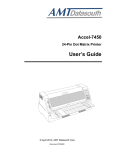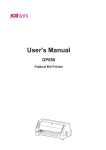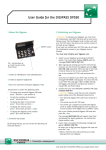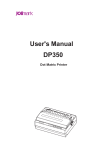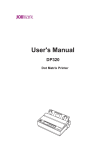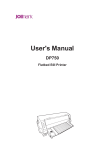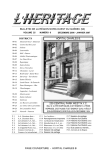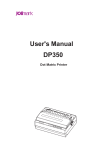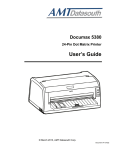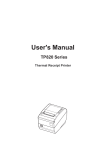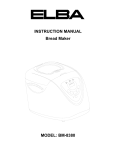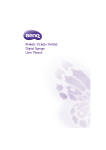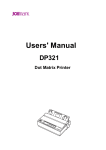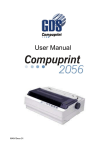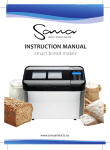Download User`s Manual
Transcript
User's Manual DP550 Dot Matrix Printer DP550 User’s Manual Important Safety Instructions 1. Read all of these instructions carefully and thoroughly and save them for later reference. 2. Follow all warnings and instructions in the manual as well as marked on the product. 3. Unplug this product from the power outlet before cleaning. Do not use liquid or aerosol cleaners. Use a damp cloth for cleaning. 4. Do not use this product near water. 5. Do not place this product on an unstable cart, stand or table. The product may fall, causing serious damage to you or the product. 6. Slots and openings on the cabinet and the back or bottom are provided for air ventilation. To ensure reliable operation of the product and to protect it from overheating, do not block or cover these openings. The openings should never be blocked by placing the product on a bed, sofa, rug or other similar surface. This product should never be placed near or over a radiator or heater. This product should not be placed in a built-in installation or kiosk stand unless proper ventilation is provided. 7. This product should be operated from the type of power source indicated on the rating label. If you are not sure of the type of power available, consult your local dealer or an electrician. 8. Depending on the country of shipment this product may be equipped with a 3-wire grounding-type plug, a plug having a third (grounding) pin. This plug will only fit into a grounding-type power outlet. This is a safety feature. If you are unable to insert the plug into the outlet, contact your local electrician to replace your obsolete outlet. Do not defeat the safety purpose of the grounding-type plug. 9. Do not allow anything to rest on the power cord. Do not locate this product in a location where the power cord will be walked or driven over or on. 10. Never push objects of any kind into this product through cabinet slots as they may touch dangerous voltage points or short out parts that could result in a risk of fire or electric shock. Never spill liquid of any kind on the product. 11. Except as explained elsewhere in this manual, do not attempt to service this product yourself. The Opening and removing those covers that are marked "the Do Not Remove" may expose you to dangerous voltage points or other hazardous risks. Leave all servicing on those compartments to qualified service personnel. 12. The mains plug on this equipment must be used to disconnect the mains power. 13. Unplug this product from the power outlet and leave servicing to qualified service personnel under the following conditions: A: When the power cord or plug is damaged or frayed. B: If liquid has been spilled into the product. C: If the product has been exposed to rain or water. D: If the product does not operate normally when the operating instructions are followed. Adjust only those controls that are covered by the operating instructions since importer adjustment of other controls may result in damage and will often require extensive work by a qualified technician to restore the product to normal operation. E: If the product has been dropped or the cabinet has been damaged. F: If the product exhibits a distinct change in performance, indicating a need for service. Note: The contents of this manual may be changed without prior notice. * All parts of the printer can be recycled. When it is abandoned, we can call it back freely. Please contact us when you abandon it. -i- DP550 User’s Manual TABLE OF CONTENTS Important Safety Instructions.................................................................................................................i Chapter 1 Overview ................................................................................................................................1 1.1 Features..........................................................................................................................................1 Chapter 2 Preparation ............................................................................................................................3 2.1 Unpacking & Checking....................................................................................................................3 2.2 Unpacking Protective Materials.......................................................................................................3 2.3 Parts Identification ..........................................................................................................................3 2.4 Installing the Printer ........................................................................................................................4 2.5 Installing the Front Table .................................................................................................................5 2.5.1 Install the Front Table ...............................................................................................................5 2.5.2 Uninstall the Front Table...........................................................................................................5 2.6 Installing the Paper Feed Knob.......................................................................................................6 2.7 Installing the Ribbon Cartridge........................................................................................................6 2.8 Connecting the Interface Cable ......................................................................................................7 2.8.1 Connecting to the Parallel Interface .........................................................................................7 2.8.2 Connecting to the USB Interface ..............................................................................................8 2.8.3 Connecting to the Serial Interface ............................................................................................8 2.8.4 Connecting to the Ethernet Interface........................................................................................8 2.9 Connecting to the Power Source ....................................................................................................9 2.10 Installing Driver .............................................................................................................................9 2.11 Network Settings .........................................................................................................................11 2.11.1 Connecting Printer................................................................................................................12 2.11.2 Setting IP Address ................................................................................................................12 2.11.3 Installing Printer Network Driver ...........................................................................................14 Chapter 3 Loading Paper .....................................................................................................................22 3.1 Adjust the Position of the Gap Adjust Lever ..................................................................................22 3.2 Using Single Sheet Paper.............................................................................................................22 3.3 Using Tractor Paper ......................................................................................................................23 3.3.1 Installing Tractor Paper...........................................................................................................24 3.3.2 Tearing Tractor Paper .............................................................................................................25 Chapter 4 Control Panel.......................................................................................................................26 4.1 Control Panel Keys, Indicator lights and LCD ...............................................................................26 4.1.1 Control Panel..........................................................................................................................26 4.1.2 Indicator light ..........................................................................................................................26 4.1.3 LCD ........................................................................................................................................26 4.2 Basic Control Panel Operations ....................................................................................................26 4.3 LCD Setup ....................................................................................................................................27 4.4 The LCD Setup Descriptions ........................................................................................................27 4.5 Top of Form Adjustment Mode ......................................................................................................27 4.6 Tear-off Adjustment Mode .............................................................................................................28 4.7 Changing the Printing Settings .....................................................................................................28 4.7.1 Using LCD Setting Menu........................................................................................................28 4.7.2 Using Setup Menu System.....................................................................................................28 4.7.3 Online-aptitude Parameter Settings .......................................................................................32 4.8 Description of Options...................................................................................................................33 4.9 Restoring Factory Printer Settings (Without Alignment and the Gap of Print-head) ......................34 4.10 Using the Self -Test Functions ....................................................................................................34 4.10.1 Maintenance Printing Test (H pattern) ..................................................................................34 4.10.2 Pin Test ................................................................................................................................34 4.10.3 Slide Pattern Printing Test ....................................................................................................35 4.10.4 Chinese Self-text ..................................................................................................................35 4.10.5 Hex Dump Mode ..................................................................................................................35 4.10.6 Alignment Adjust Mode.........................................................................................................35 Appendix A............................................................................................................................................37 - ii - DP550 User’s Manual A.1 Printer Maintenance .....................................................................................................................37 A.2 Problems and Solutions................................................................................................................37 Appendix B Specification ....................................................................................................................39 B.1 General.........................................................................................................................................39 B.2 Paper Specifications .....................................................................................................................40 B.3 Printable Area ...............................................................................................................................41 B.3.1 Cut Sheet, Check, Post Card .................................................................................................41 B.3.2 Tractor Paper .........................................................................................................................42 B.4 Interface Specification ..................................................................................................................42 B.4.1 Parallel Interface ....................................................................................................................42 B.4.2 USB Interface.........................................................................................................................43 B.4.3 Serial Interface.......................................................................................................................43 B.4.4 Ethernet Interface ..................................................................................................................45 B.5 Paper Specification and Printable Area ........................................................................................46 B.5.1 The Notice Proceeding Relates to Print Paper.......................................................................46 B.5.2 Nested Table Used Print Paper..............................................................................................46 B.5.3 Useable Print Paper Types and Guarantee Area ...................................................................47 B.5.4 Tractor Paper(Continuous Bill) ..........................................................................................47 B.5.5 Cut Sheet ...............................................................................................................................51 B.5.6 Post Card ...............................................................................................................................54 B.5.7 Envelope ................................................................................................................................56 B.5.8 Label ......................................................................................................................................57 B.5.9 Delivery Bill ............................................................................................................................59 B.5.10 Reborn Paper.......................................................................................................................59 - iii - DP550 User's Manual Chapter 1 Overview 1.1 Features Thank you for purchasing this Jolimark printer. This versatile, 24-pin, flatbed High speed Bill printer is ideal for a wide range bill printing requirements, includes national standards GB18030 big capacity Chinese character set, elaborated design in speed, copy capability and paper thickness applicability. Especially for value-added tax invoice, common invoice, various service trade invoice, narrow card printing and continuously bill printing. Flatbed Paper-feed Mechanism Flatbed paper-feed mechanism can avoid crease caused by tractor rolling. So that some document papers, such as multi-copy invoice, envelope, postcard and label and so on, can smoothly in and out without jam. Automatic paper Load/Eject Function Cut sheet may be fed from the front of the printer automatically. Finish printing, the paper may be automatically fed back to the front of the printer. Tractor paper is installed on the tractor. Press LOAD/EJECT key, paper may be fed to print position automatically. Finish printing, the paper may be fed to the front of the printer in order to tear conveniently. Zero tear-off Function This causes tractor paper to be automatically fed to the tear-off position at the edge of the window cover, for easy tear-off at the perforations after printing. This zero tear-off capability helps eliminate paper wastage. Paper Eject Function This function allows users pressing the facility function button on the control panel to eject the cut sheet or tractor paper from the printer. High Resolution Graphics A maximum resolution of 360 × 360 DPI enables the printer to produce fine, sharp graphics. Emulation The printer supports the OKI 5530SC and Epson ESC/PK2 emulation as standard. Large Capacity Data Buffer Area 132KB large capacity data buffer area can minimize the employing time of your computer, it allows your computer to release the printing buffer area to other work. Contain Letter Character Font This print contain variously font of Roman, Sans Serif, Courier, Prestige, Script, OCR-A, Orator and so on which making printed document prettier. Bar Code Function The printer contains the following standard bar codes: EAN-13, EAN-8, Interleaved 2 of 5, Matrix 2 of 5, Industrial 2 of 5, Code 39, Code 128 B, Code 128 C, NW-7. User- Friendly Control Panel Current print status and access to all printer functions is available via simple commands from the control panel. In addition, the control panel is used to access the menu system (Setup Menu System) with complete control over the printer’s set-up functions. Automatic Interface Switching The DP550 includes a parallel interface, an USB interface, an Ethernet interface or serial interface. (According to the specific interface standards) The printer automatically detects the type of data transfer -1- DP550 User's Manual received from the host computer and switches to the corresponding interface type. Compressing Printing You can set compress print proportion through modifying the Menu System Setting of the printer. (Caution: High Speed mode and Super High mode is invalidated while the printer in Compress printing mode.) In addition, you can set the compress printing through driver. (Only set the compress printing through driver can High Speed printing mode and Super High Speed printing mode are valid.) The compress proportion of these two setting methods is compress relationship. Automatic Paper Edge Detection (Optional) The printer can detect the edge of the paper which ensure the printing contents are all within the printable area. Automatic Paper Skew Detection (Optional) The printer can detect the lean of the paper. If it is over the set lean, the printer will eject the paper automatically so that you can ensure the printing quality. Contain Break Pin Compensation Function User can set the printer to print using the pin which is in good condition to compensate the break pin. Pin Switch Printing Mode User can set pins to switch while printing form transverse line in order to improve print head life. -2- DP550 User's Manual Chapter 2 Preparation 2.1 Unpacking & Checking Check each item against the following packing list, if any of these items are missing, please contact your dealer. B A E D C F G H Figure 2-1 Packing list in the printer box A B C D E F G H Printer Front table Ribbon cartridge (JMR118) Paper feed knob Driver CD (Including user's manual and driver) Interface cable Facility user's guide Packing list Note: The fittings please refer the packing list. The packing style above is subject to change without notice. 2.2 Unpacking Protective Materials 1. Open the packing box, lift up the printer, then tear off the Sealing colloid on both sides of the printer cover. 2. Save all the original packing materials, so that it can be used when transport the printer. Sealing colloid Figure 2-2 Unpacking the sealing colloid 2.3 Parts Identification Figures 2-3 and 2-4 highlight the main parts of the printer. -3- DP550 User's Manual Top cover LCD display Gap adjust lever Control panel Paper guide Paper feed knob Power switch Front table Print head Paper select lever Ribbon cartridge Figure 2-3 Main parts of printer (front view) Tractor Power cord USB interface Parallel interface Serial interface or Ethernet interface Figure 2-4 Main parts of printer (rear view) ★ According to specific interface standards 2.4 Installing the Printer Before placing the printer in your chosen location, consider the following guidelines: This printer should be placed on a normal table, printer stand or desk. Be sure that the surface is level, to avoid an uneven load on the carriage as it operates. Do not place the printer where belong to the following conditions: The place is overheating or humidity. The place is shaking. Do not install the printer where it may be subjected to unsuitable conditions such as: ·Where there is excessive dust. ·Where it may be splattered with oil or metallic dust. ·Where it may be exposed to direct sunlight. ·Where it may be accidentally splashed with water. -4- DP550 User's Manual Place space About 60cm About 130cm ≥60 cm About 10cm About 10cm Wall About 30cm About 130cm About 70cm Floor Figure 2-5 Printer placement 2.5 Installing the Front Table 2.5.1 Install the Front Table As the follow figure, insert the front table in the slot of the printer's foreside, and put it horizontal to lock it. Front table Hook Figure 2-6 Installing the front table 2.5.2 Uninstall the Front Table Hold both sides of the front table, and pull up the front table to disengage hooks from slots. -5- DP550 User's Manual 2.6 Installing the Paper Feed Knob The openings of the Paper feed knob aim at the pin, then insert. Long pin Figure 2-7 Installing the paper feed knob 2.7 Installing the Ribbon Cartridge 1. Turn off the printer. 2. Hold the concaves of the top cover to open the printer cover. (As figure 2-8 shown) Top cover Print head 1 2 Figure 2-8 Opening the top cover 3. Pull the gap adjust lever to the highest position. 4. Slide the print head to the middle of the printer. (As figure 2-8 <2>shown) Note: Never remove the print head when printer is on, or else the printer may get damaged. Besides, do not touch the print head at the time finishes using the printer for overheating. Ribbon Knob Ribbon cartridge (JMR118) Ribbon core Ribbon nip Figure 2-9 Ribbon cartridge 5. Turn the ribbon knob in the direction of the arrow to remove any slack from the ribbon so it is easier to install. (As figure 2-9 shown) 6. As figure 2-10 shown. Hold both sides of the ribbon cartridge, then press it down firmly to fit the hooks into the install grooves of the printer. Then aim the two round holes of the ribbon nip at the -6- DP550 User's Manual two guide poles of the carriage frame. Carriage guide pole Ribbon nip Figure 2-10 Installing the ribbon cassette 7. Turn the ribbon knob in the direction of the arrow to remove any slack from the ribbon again, ensure the there is no crease in the ribbon core. 8. Slide the print head from side to side to make sure it moves smoothly. 9. Pull the gap adjust lever back to the original position and close the top cover. Note: 1. When your print becomes faint, you need to replace the ribbon cartridge. Otherwise, the print quality will be affected and the print head may be damage. 2. To remove the old ribbon cartridge, first make sure the power is turned off, move the print head to the center of the printer. Then hold the ribbon cartridge handle on both sides and lift it out of the printer forwards. Install a new one as the above steps. 3. Please use the Jolimark JMR118 ribbon cartridge, our company will not guarantee to keep the printer in good repair, when it is damaged by unauthorized ribbon cartridge. 2.8 Connecting the Interface Cable Your printer contains a parallel interface, a USB interface, a serial interface or Ethernet interface. (According to specific interface standards) Connect your computer to the printer with corresponding interface cable. (As figure2-11, 2-12, 2-13, 2-14shown) Note: Before connecting the parallel interface or the serial interface, please make sure the power of the printer is shut down. Must after tighten the cable you may turn on the power, or it will damage the printer. 2.8.1 Connecting to the Parallel Interface 1. Turn off both the computer and the printer. Plug the parallel cable connector securely into the printer's parallel interface. Squeeze the wire clips together until they lock in place on both sides of the connector. 2. Plug the other end of the cable into the computer's parallel interface; then tighten the screws on both sides of the connector. -7- DP550 User's Manual Wire clips Parallel interface Parallel cable Figure 2-11 Connecting to the parallel interface 2.8.2 Connecting to the USB Interface 1. Plug the USB cable A end (flat shape) into the computer's USB interface. 2. Plug the USB cable B end (square shape) into the printer's USB interface. Note: Don't impact the plug after connecting to the USB cable. USB interface USB cable ythh Figure 2-12 Connecting to the USB interface 2.8.3 Connecting to the Serial Interface 1. Turn off both the computer and the printer. Plug the serial cable connector securely into the printer's serial interface. Then tighten the screws on both sides of the connector. 2. Plug the other end of the cable into the computer's serial interface; then tighten the screws on both sides of the connector. Screw Serial cable Serial interface Figure 2-13 Connecting to the serial interface 2.8.4 Connecting to the Ethernet Interface Plug the RJ-45 crystal plug of the Ethernet cable into the printer, and plug the other plug into the LAN.(As figure 2-14 shown). -8- DP550 User's Manual Ethernet interface Ethernet cable Figure 2-14 Connecting to Ethernet interface Note: The details of Ethernet interface printer’s net setting please refer to the User’s Manual. 2.9 Connecting to the Power Source 1. Make sure the printer is turned off. 2. Make sure the voltage required by the printer matches that of your electrical outlet. 3. Plug the power cord into a properly grounded electrical outlet. Power cord Electrical outlet Power switch Figure 2-15 Connecting the power cord to the printer z To turn the printer ON, press the I mark on the power switch z To turn the printer OFF, press the O mark on the power switch. Caution: 1. If the rated voltage and your outlet voltage do not match, contact your dealer for assistance. Do not plug in the power cord. 2. Use the electrical outlet connecting the ground properly. 2.10 Installing Driver Please use the cable to connect the computer with the printer, then turn on the computer and the printer, put the driver CD into the CD-ROM. Install driver by the following way: Auto-install way Double click the file “Setup.exe” in the driver disc, install driver by the following direction. Note: Auto-install way just work in operating system of Windows2000 or above. Hand-operated install way Note: The hand-operated install ways of serial interface and parallel interface are the same. -9- DP550 User's Manual The installing steps for Windows 2000/XP/Vista are as follows 1. Click “Start” -->"Settings", select "Printers". 2. Click “Add Printer", then it will show a window of "Add Printer Wizard", click "Next", then please read the select direct carefully, Such as, select "Local printer” in the "Local or Network Printer" window, then click "next". 3. Come out a window of "Select the Printer Port”, select a usable port. Such as, select "LPT1: printer port”, click "Next”. 4. Come out a window of "Manufacturers/Printers", click "Have Disk...", click "Next". 5. Come out a window of "Install From Disk". Please according to the operating system environment, you should select the path as follow: CD-ROM-"Driver"-"WIN 2000 (XP-Vista-Win7)", that you can find a file named: DP550.inf, click "Open", then click "OK”, click "Next". 6. Follow the direct click “Next" gradually till the installation is finished. The installing steps for Windows 7 are as follows: 1. Click “Start” -->"Devices and Printers”. 2. Click “Add a printer”, then it will show a window of “Add Printer”, click “Add a local printer”, and then click “Next”. 3. Come out a window of “Choose a printer port”, select “Use an existing port”, Such as, select “LPT1: Printer Port”, click “Next”. 4. Come out a window of "Manufacturers/Printers", click "Have Disk...", click “Next”. 5. Come out a window of “Install From Disk”. Please according to the operating system environment, you should select the path as follow: CD-ROM-“Driver”-“WIN2000 (XP-Vista-Win7)”, where you can find a file named: DP550.inf, click “Open”, then click “OK” to return to the window of "Manufacturers/Printers", click “Next”. 6. Follow the direct click “Next” gradually till the installation is finished. The USB interface installing steps for Windows 2000/XP/Vista/Win7 are as follows: The following steps are used Windows XP as example. There are slight differences among different operating systems. 1. Connect an USB cable and turn on the printer. 2. After the computer find out new hardware and finish searching, come out a window of “Add New Hardware Wizard”, click "Next". 3. Come out a window of "Add New Hardware Wizard" ——"Windows operation" , choose” Not Search, I want to Choose the Setup Driver (D)”, click "Next". 4. Come out a window of "Manufacturers/Printers", click "Have Disk...” click “Next”. 5. Come out a window of “Install From Disk”. Please according to the operating system environment, you should select the path as follow: CD-ROM-“Driver”-“WIN2000 (XP-Vista-Win7)”, where you can find a file named: DP550.inf, click “Open”, then click “OK” to return to the window of "Manufacturers/Printers" , click “Next”. 6. Follow the direct click “Next” gradually till the installation is finished. The installing steps for Windows 98 are as follows: (1)The installing steps with a parallel cable: 1. Click "Start" -->"Settings"-->"Printers". 2. Click "Add Printer", then it will show a window of "Add Printer Wizard", click "Next", then please read the select direct carefully, Such as, select "Local printer" in the "Local or Network Printer" window, then click "Next". 3. Come out a window of "Click the manufacturer and model of your printer”, click "Have Disk...", - 10 - DP550 User's Manual please click "Browse", select the path as follow : CD-ROM-"Driver"-"WIN98 (WINME) ", where you can find a file named: DP550.inf, click "Open", then click "OK". 4. Come out a window of “Install From Disk”, click "OK, return to a window of "Add Printer", then click "Next". 5. Come out a window of "Printer port", select "Available ports", Such as, select "LPT1: Printer Port", click "Next", and then show the printer’s name. If the system is not installed by other printer driver process, the printer is treated as default printer by the application process of Window98 environment, click "Next". Otherwise according to prompt, choose the printer is default: "Yes", click "Next", choose "Yes-(recommended)", click "Finish". Come out a window of "Printer test page completed!", click "Yes". 6. The printer driver process is installed successfully. (2)The installing steps with an USB cable: Note: 1. As the system of Windows 98/ME doesn’t have integrated USB driver control, please install USB driver before using USB interface printing. Then install USB printer driver. 2. If it has installed the USB driver, please install the USB printer driver directly as the following steps. USB driver installing steps: 1. Connect an USB cable and turn on the printer. 2. After the computer find out new hardware and finish searching, come out a window of "Add New Hardware Wizard", click "Next". 3.Come out a window of "Add New Hardware Wizard" —"Windows operation" ,choose "Search the best driver for the device(recommended)", click "Next". 4. Come out a window of "Search for new drivers", check "Specify a location", click ”Browse" , select the path as follows: CD-ROM-“Driver”-"【WIN98(WINME)\USBdriver】", then click "OK". 5. Return to a window of "Search for new drivers", click "Next"; Come out a window of "Windows driver file search for the device”, click "Next". 6. After the system finishing installing the file automatically, come out a window of "USB print supported, click "Finish". 7. The printer USB driver process is installed successfully. USB printer driver installing steps: 1. Click "Start" -->"Settings"-->"Printers" 2. Click "Add Printer", then it will show a window of "Add Printer Wizard", click "Next". 3. Come out a window of "Click the manufacturer and model of your printer", click "Have Disk...", please click "Browse", select the path as follow : CD-ROM-"Driver"-"WIN98 (WINME) ", where you can find a file named: DP550.inf "Open", and then click "OK". 4. Come out a window of “Install From Disk”, click “OK”, return to a window of “Add Printer", then click "Next". 5. Come out a window of "Printer port", select "Available ports", select "JMUSB", click "Next", and then show the printer’s name. If the system is not installed by other printer driver process, the printer is treated as default printer by the application process of Window98 environment, click "Next”. Otherwise according to prompt, choose the printer is default: "Yes", click "Next" choose "Yes-(recommended)", click "Finish". Come out a window of "Printer test page completed!", click “Yes". 6. The printer driver process is installed successfully. 2.11 Network Settings Please use Jolimark network setting software NetFinder to set the IP address for Jolimark printers, which can be found in the CD or downloaded from www.jolimark.com. - 11 - DP550 User's Manual Caution: The network printing function needs the operation system of Windows2000 or above. 2.11.1 Connecting Printer Power on the printer, connect with the Ethernet cable which has been connected to LAN, and look into the information of Ethernet LED indicator to ensure the printer has entered into the normal connection. Yellow LED ON OFF Green LED Blink OFF Description Normal Not connect to network 2.11.2 Setting IP Address 1. Run NetFinder Software Double click NetFinder.exe in the PC which connects the printer in the same LAN. The figure of the software is shown as follows: Button description: Exit—Exit from the software Search—Search printers in the same LAN Assign IP—Modify the IP address and other settings for the specified printer. 2. Search printer Click “Search” button in the main interface, the dialog box appearing will begin searching automatically and show appearance, listing a printer in the main interface if found. The time is counting down in the progress bar (10s in total) and the search will finish as soon as the time is over. When going on searching, press “search” button again. - 12 - DP550 User's Manual If the printer still can not be found out when the network connection is correct and in the same network, Please check whether the network fire wall on the PC open or not. If there is a fire wall, please close it temporarily, open it again after finishing searching and setting a printer completely. 3. Setting printer’s IP address The printer’s information is listed in the main interface, the left side of which is the model and description and the right is the IP and MAC address. What’s more, the assign mode (dynamic/static) is noted behind the IP address. 1) Correlative description for IP address settings In order to search and set printer’s IP address conveniently for the first time, the factory default setting is DHCP mode which assigns IP address dynamically. If there is no DHCP server in the connected LAN and printer is set to DHCP mode as well, then it will use the internal pre-set address (IP: 10.0.0.1, Subnet Mask: 255.255.255.0) automatically. It is suggested that printer’s IP set to static in actual usage, which can cut down the time when initializing the Ethernet interface as the printer is turned on and prevent IP conflicts (The dynamic - 13 - DP550 User's Manual address used in printer may conflict with another one). The network segment part of the IP address and Subnet Mask must be the same as those of PC connecting with a printer. For example, the address of working PC is 192.168.0.1/255.255.255.0 (IP/Subnet Mask),then which of printer should be set to 192.168.0.x/255.255.255.0(x=2~254 and should avoid the IP in used. It is not restricted for NetFinder to search printers in the same network but different segment parts (can not stride gateway). Relative glossary of IP address may refer to corresponding information. 2) Setting printer’s IP address Select the printer information to be modified (black frame appears), click “Assign IP” button. Set the IP in the dialog box appearing. Check the “Use DHCP” if need to assign dynamic address, the settings above will be disabled automatically. Please make sure there is a DHCP server in the network, or the printer can not receive an effective IP address. When to specify static address, uncheck “Use DHCP” and fill in “IP address”, “Subnet Mask” and “Default Gateway”. If there is no gateway in the network, fill 255.255.255.255 in the “Default gateway”. “IP address” and “Subnet Mask” should obey the assigning rules of local LAN (Ethernet), please enquire the administrator of networks which the printer connects to for more details. Click “OK” to send address setting information to the specified printer. The printer takes response after “Close this window on success” is checked, and then this dialog is closed automatically. Select “Reload Timer” then the software will wait for the printer’s response. Generally, printer will take response in a circle time if network connection is correct. Click “Cancel” if you abandon the modification. Click “Search” in the main interface again to update printer information after modifying the printer’s IP address. 3) Report printer’s IP address Report the printer’s IP address, which will be used in the section “Newly-install printer network driver” or “Upgrade-install printer network driver (setting driver’s network port)”. 2.11.3 Installing Printer Network Driver The ways of installing network driver are divided into Newly-install way and Upgrade-install way according to whether the PC installs the printer driver or not. If the printer driver hasn’t been installed on the PC, adopt newly-install way whose steps are shown - 14 - DP550 User's Manual in “Newly-install printer network driver”. If the printer driver has been installed on the PC, adopt Upgrade-install way whose steps are shown in “Upgrade-install printer network driver”. 1. Newly-install printer network driver 1) Click “Start”Æ”Settings”, select “Printers. 2) Click “Add printer”, then come out a window of “Add Printer Wizard”, click “next”, 3) Come out a window of “Add Printer Wizard”, then please read the select direct carefully. Such as, select “local or Network Printer”, then click “next”. 4) Come out a window of “Select the Printer port”, select a port you want your printer to use. For example, select “Create a new port”, select “Standard TCP/IP Port” in the port, click “next”. 5) Come out a window of “Add standard TCP/IP Printer Port Wizard”, click “Next”. 6) Come out a window of “Add Port”, enter the IP address reported by the “Setting printer’s IP address” in the “Printer Name or IP Address” column. Take IP address “192.168.0.240” for example. “Port Name” is created automatically after finishing filling in IP address. - 15 - DP550 User's Manual 7) Come out a window of “Additional Port Information Required”, select “Custom” in the “Device Type”, and then click “Settings”. 8) Come out a window of “Port Settings”. Affirm that “Port name” and “Printer name or IP address” are correct, “Protocol” is “RAW” and “Port Number” is “9100”, click ”OK”. - 16 - DP550 User's Manual 9) Return to “Additional Port Information Required”, click “Next”. 10) Come out a window of “Completing the Add Standard TCP/IP Printer Port Wizard”, click “Finish”. 11) In the selection of "Manufacturers/Printers", click “Have Disk”, and then click “Next”. 12) Come out a window of “Install From Disk”. Please according to the operating system environment, such as Windows XP operating system you should select the path as follows: CD-ROM-“Driver”-“WIN2000(XP-Vista-Win7)”, that you can find a file named: DP550.inf, click “open”, then click “OK”, then return to the window “install printer software”, click “next”. 13) Follow the direct click “next” gradually till the installation is finish. At this time, printer network driver is installed completely. 2. Upgrade-install printer network driver (setting driver’s network port) If PC has installed the printer’s driver, set driver’s network port to carry out network printing. The concrete steps are shown below: 1) Click “Start”Æ”Settings”, select “Printers” 2) Right click DP550 driver, click “Properties” on the window coming out. 3) Come out a window of “Properties”, click “Ports” and “Add Ports”. - 17 - DP550 User's Manual 4) Come out a window of “Printer port”, select “Standard TCP/IP Port”, click “New port”. 5) Come out a window of “Add Standard TCP/IP Printer Port Wizard”, click “Next”. 6) Come out a window of “Add a port”, import the IP address reported by the “Setting printer’s IP address” in the “Printer name or IP address” column. Take IP address “192.168.0.240” for example. “Port name” is created automatically after finishing filling in IP address. Click “Next”. - 18 - DP550 User's Manual 7) Come out a window of “Additional Port Information Required”, select “Custom” in the “Device Type”, then click “settings”. 8) Come out a window of “Port Settings”. Affirm that “Port name” and “Printer name or IP address” are correct, “Protocol” is “RAW” and “Port Number” is “9100”, click ”OK”. - 19 - DP550 User's Manual 9) Return to “Additional Port Information Required”, click “Next”. 10) Come out a window of “Completing the Add Standard TCP/IP Printer Port Wizard”, click “Finish”. 11) Return to “Printer Ports”, click “Close 12) Return to “Properties”, make sure the network port is selected, click “Apply”, and then click “Close”. Thus, printer’s network port setting is finished. - 20 - DP550 User's Manual - 21 - DP550 User's Manual Chapter 3 Loading Paper 3.1 Adjust the Position of the Gap Adjust Lever Adjust the paper-thickness Regardless fixing cut sheet paper or tractor paper should adjust the gap adjust lever which on the left of the printer first. The gap adjust lever can heighten or lower the carriage to adapt the paper thickness. To be sure have good printing quality and prevent the paper jam happening, you need to pull the lever to the corresponding position according to the paper thickness. (as figure 3-1shown). Table 3-1paper thickness setting table Position Paper type -1 Thin paper 0 Cut sheet 1 2~3 2 4~5 3 6~7 1~5 Gap adjust lever Fanfold paper Card / Envelope Figure 3-1 Adjust the gap adjust lever Remark: Lever position -1 0 1 2 3 4 5 6 Paper thickness Less than 0.06mm 0.06mm ~ 0.12mm 0.13mm ~ 0.23mm 0.24mm ~ 0.34mm 0.35mm ~ 0.45mm 0.46mm ~ 0.56mm 0.57mm ~ 0.67mm 0.68mm ~ 0.80mm 3.2 Using Single Sheet Paper Set the cut sheet paper mode Turn the Paper select lever to the cut sheet paper position as shown in Figure 3-2. Cut sheet Paper select lever Figure 3-2 Adjust the Paper select lever - 22 - DP550 User's Manual Note: When changing the type of the paper, please push the paper select lever to the end to insure the paper select lever in the cut sheet mode. Installing cut sheet z z z Turn on the printer. Insure the paper select lever in the cut sheet mode. Set the position of the paper based on the scale of the front table. Figure 3-3 Adjust cut sheet Note: 1. Insure to print contents all in printable area, or it may cause the print head to break pin. 2. When printing a card, please move the paper guide to “the card position”. As shown in Figure3-4 insert a paper, the paper will move to the print position automatically. Figure 3-3 Installing cut sheet Remark If you have set the printer menu “Paper insert and wait” in the “press key to insert paper” mode, the paper will not move to the print position automatically. But now you can press the “LOAD/EJECT” to move the paper to the print position. It will have more description about “the change of the printer’s set” in the next chapter. 3.3 Using Tractor Paper The tractor of the printer will feed the tractor paper from back to front as shown in Figure 3-5. - 23 - DP550 User's Manual Figure 3-4 Move direction of the tractor paper 3.3.1 Installing Tractor Paper 1. Turn on the printer. 2. Insure the paper select lever in the tractor paper mode as shown in Figure 3-6. Paper select lever Tractor paper Figure 3-5 Adjust the Paper select lever Note: When changing the type of the paper, please push the paper select lever to the end to insure the paper select lever in the tractor paper mode. 3. Pull up the tractor lock, adjust the print position, and then push back the tractor lock. Figure 3-6 Pull up the tractor lock 4. Open the tractor and put tractor paper in the tractor as shown in Figure 3-8. Tractor Figure 3-7 Put tractor paper in the tractor - 24 - DP550 User's Manual Remark Please align the tractor paper to the edge of tractor as shown in Figure 3-9. Tractor (gear cover) Top of paper Figure 3-9 Install tractor paper to tractor gear 5. Adjust the right tractor to affirm the installation is correct. Insure the hole of the tractor paper suit extrude of the tractor as shown in Figure 3-10. Figure 3-9 Adjust the position of the right tractor Note: Please don’t let the tractor paper be over tight or lax. 3.3.2 Tearing Tractor Paper When the printer leaves factory, the function of feeding paper to tear off position has been opened. After finish printing, the printer will feed the tractor paper to tear off position automatically. Paper can be torn off along the printer cover edge. (As Figure 3-11 shown) If the printer default setting has been changed, the function of feeding paper to tear off position has been closed. After finish printing, press TEAR key can feed the paper to tear off position. Before tearing off tractor paper, if the margin doesn’t aim at the printer cover edge, please adjust the tear off position. (Please refer to Tear-off Adjustment Mode on Chapter 4 Control Panel) Figure 3-10 Tear tractor paper - 25 - DP550 User's Manual Chapter 4 Control Panel 4.1 Control Panel Keys, Indicator lights and LCD 4.1.1 Control Panel The control panel consists of four keys and two indicator lights as shown in Figure 4-1. Figure 4-1 Control panel 4.1.2 Indicator light LEDs ON Power/Paper out(red) the printer is turned on. Online(green) the printer is online. Blink OFF paper out and during error condition the printer is turned off. — the printer is offline. 4.1.3 LCD 票据 速度 普通 正常 复写能力 撕纸 自动 3 联纸 4.2 Basic Control Panel Operations 联机 Pressing the ONLINE key, switch between ONLINE and OFFLINE mode. (ONLINE) 进纸/退纸 (LOAD/EJECT) In cut sheet mode, press this when offline, the printer will eject the paper. When paper in ready position, press this key when offline, paper will be fed to the printing home position. When paper in, press this key in offline, the paper - 26 - DP550 User's Manual 换行/换页 (LF/FF) 撕纸 (TEAR) will be fed to the ready position. In the offline mode, press the LF/FF key to feed the paper line by line. Alternatively, hold the LF/FF key down, the printer will eject the cut sheet or feed the tractor paper to tear off position. If the printer uses the tractor paper in the offline mode, pressing the TEAR key, the tractor paper switch between the tear-off position and the printing home position. 4.3 LCD Setup 1. Holding the “联机”(ONLINE) key for 3 seconds, the “票据” of the LCD will blinks with one beep, and the printer is in the LCD SETUP MODE. 2. You can press the “進紙/退紙”(LOAD/EJECT) key to select the item of the LCD, and the current item of the LCD blink. 3. You can press the “换行/换页”(LF/FF) key to select the submenu, and the current submenu is shown. 4. After you have completed the LCD setup, you can press the “联机”(ONLINE) key to save and exit the LCD setup mode. 4.4 The LCD Setup Descriptions Item Submenu Descriptions 票据 增值税票,普通 Set the type of bill. 速度 正常,高速,超高速 Set the print speed mode. “正常”: is normal speed; “高速”: is high speed; “超高速” is super high speed. 复写能力 3 联纸,5 联纸,7 联纸 Set the copy mode. “X 联纸”: Symbolize the impact force. “3 联纸” is the normal impact force. “7 联纸” is the best impact force, and each row will print twice. 撕纸 自动,手动 Set the tear mode. “自动”: When printing is completed, the paper feeds to tear off position automatically. “手动”:You should press the TEAR key to feed the tractor paper to tear off position. 4.5 Top of Form Adjustment Mode The top of form setting determines the margin between the top of paper and the first printed line (the top margin). The printing advance direction is positive value, the reverse direction is negative value. Install paper correctly, press LOAD/EJECT to feed paper to printing position. In the ONLINE mode, press the LF/FF key for about 3 seconds to enter the top of form adjustment mode. The ONLINE and POWER LED will blink alternating. Use the LOAD/EJECT and LF/FF keys to alter the top of form setting: LOAD/EJECT: Increase the top of form by 1/60 inch. You can increase the margin to a maximum of +60 increments (+60/60 inch) from the factory setting. LF/FF: Decrease the top of form by 1/60 inch. You can decrease the margin to a maximum of 0 (0/60 inch) from the default setting. To exit and save your new setting, press the ONLINE key. The POWER LED and ONLINE - 27 - DP550 User's Manual LED blink simultaneously twice with two beeps, and then the POWER LED will be on. Caution: When the top of form position is maximal, press LOAD/EJECT key, the printer will not increase. When the top of form position is minimal, press LF/FF key, the printer will not decrease. Note: To exit without saving, just turn the printer OFF. 4.6 Tear-off Adjustment Mode There is a tear-off bar at the edge of the window cover. When you have finished printing, you can advance the tractor paper on the tracker to the tear-off bar by the tear-off function to easily tear off the perforated sheets. The tear off setting determines the distance between the perforation of tractor paper and the tear-off bar. Install tractor paper correctly, press TEAR key to feed paper to tear off position. With the printer online, press both the LOAD/EJECT and LF/FF keys for about 3 seconds to get the printer to enter the tear-off adjustment mode. When the printer enters this mode, the ONLINE LED and the POWER LED blink alternately. Use the LOAD/EJECT and LF/FF keys to alter the tear-off setting: LOAD/EJECT: Press the LOAD/EJECT key to adjust the distance in 1/60 inch increments. You can maximum increase to +15/60 inch LF/FF: Press the LF/FF key to adjust the distance in 1/60 inch decrements. You can maximum decrease to 0/60 inch To exit and save your new setting, press ONLINE key. The POWER LED and the ONLINE LED blink simultaneously for twice with two beeps, then the POWER LED turns on. Your new tear-off setting value is saved. Caution: When the tear off position is maximal, press LOAD/EJECT key, the printer will not increase. When the tear off position is minimal, press LF/FF key, the printer will not decrease. Note: To exit without saving, just turn off the printer. 4.7 Changing the Printing Settings DP550 printers divide printer settings into three sections: LCD setting menu, Setup Menu System and Online-aptitude Parameter Settings. 4.7.1 Using LCD Setting Menu Press ONLINE key for about 3 seconds to enter LCD setting menu. In LCD setting menu, press LOAD/EJECT key to switch the setting items, such as Bill, speed, Copy and so on, the selected item blinks. Press LF/FF key to select the contents of the items, such as Normal, High speed, super high speed and so on, the selected content is shown. Press ONLINE key to save and exit the LCD setting menu after setting the menu. 4.7.2 Using Setup Menu System Print out the current settings as following steps: 1. Turn off the printer. 2. If you use tractor paper, please install the paper correctly. (The minimal width of tractor paper is 240 mm.) 3. Press down LOAD/EJECT key and LF/FF key simultaneously and turn on the printer. The printer - 28 - DP550 User's Manual will feed the paper automatically and print out a default setting report or the current default settings. (As Figure 4-2 shown) Caution: 1.The options whose color is printed contrarily are the current settings. If the initialization of “Language” is “English”, saving the setting and operating the upper steps again, and it will print the current settings in English. The way of changing the settings is in the next section. 2. When choose compress printing mode in the menu settings system, HIGH SPEED/SUPER HIGH SPEED print mode will not be valid. - 29 - DP550 User's Manual Jolimark DP550 Current Setting MAC: 20-2C-B7-00-00-00 DHCP: YES IP: 10.0.0.1 Subnet: 255. 255. 255.0 gateway: 255.255.255.255 LANGUAGE CHINESE EMULATION CHAR. MODE OKI ASCII FONT SANS SER COURIER PRESTIGE SCRIPT ENG PITCH 12 CPI 15 CPI PROPORTIONAL CHI PITCH 7.5 CPI SLASH ZERO ON FRANCE NORWAY GERMANY DENMARK2 U.K. SPAIN 2 DENMARK1 SWEDENI LATIN AM KOREA 8 LPI 11/3INCH 3.5 INCH 4 INCH 5 INCH 5.5 INCH 12 INCH 14 INCH 2/10 INCH RIGHT MARK 3/10 INCH 4/10 INCH 5/10 INCH 005 INTL CHAR SET JAPAN OCR-B OCR-A ORATOR TALY SPAIN 1 LEGAL NETHER TURKEY GHAR. SET LINE SPACING FORM LENGTH ITALICS 3 INCH LEGAL PAGE SKIP ON COMPRESS PRI ON LEFT MARGIN BLACK MARK 1/10 INCH LEFT MARK PRINT DIR HIGH-DENSITY BI-DIR QUIET MODE AUTO LF LOADING PUSH KEY UNI-DIR ON ON 0.5 SEC. 2.0 SEC. ON OFF 001 002 003 004 4800 BPS 2400 BPS 1200 BPS PARITY ODD EVEN DATA BIT 7 BIT SKEW DETECT BAUD RATE 19200 BPS STOP BIT PROTOCOL 7 INCH ON PIN ROTATE MARGIN DETECT 6 INCH 2 BIT XON/XOFF PIN 1 BROKEN PIN 2 BROKEN PIN 3 BROKEN PIN 4 BROKEN PIN 5 BROKEN PIN PIN 6 7 BROKEN BROKEN PIN 8 BROKEN PIN 9 BROKEN PIN 10 BROKEN PIN 11 BROKEN PIN PIN 12 13 BROKEN BROKEN - 30 - 006 007 DP550 User's Manual PIN 14 BROKEN PIN 15 BROKEN PIN 16 BROKEN PIN PIN 17 18 BROKEN BROKEN PIN 19 BROKEN PIN 20 BROKEN PIN 21 BROKEN PIN 22 BROKEN PIN PIN 23 24 BROKEN BROKEN Figure 4-2 Current setting report Caution: 1. The options whose color is printed contrarily are the current settings. 2. Black mark is optional, it can be installed base on the customer’s requirement. Enter the setup menu system mode 1. The printer is in online mode. 2. Holding the “LOAD/EJECT” key for 3 seconds, The Power LED and Online LED will blink twice simultaneously which indicates that the printer enters the setup menu system. The title and main menu are printed out firstly (as Figure 4-3 shown), the default settings are underlined. Print head stays under the current default item. Jolimark DP550 Current Setting Use the LOAD/EJECT key to point the print head to the desired setting. Use the LF/FF key to confirm the current setting. Use the ONLINE key to go back the previous menu (Press and hold the ONLINE key to go back the main menu). Press and hold the TEAR key to save settings and exit. Current settings are . New settings will be FILLED. STYLE SETUP CHARACTER PAGE LAYOUT PRINT SETUP SERIAL I/F HEAD PIN To activate the newly stored settings, please turn on the power again. Figure 4-3 Enter Setup menu system 3. Using the following keys to modify the menu setting: LOAD/EJECT Select the menu option or menu setting value. LF/FF Enter into submenu or confirm menu setting value. Note: Newly setting option will be shown in FILLED. ONLINE Return to upper menu (Hold on pressing ONLINE key will return to main menu directly. TEAR Save and exit the setup menu system. 4. Give up the settings just modified, just turn off the printer directly. If you need to save the newly setting, hold on pressing TEAR key to save and exit the menu setting mode. 5. Turn off and restart the printer, newly settings are in operation. - 31 - DP550 User's Manual 4.7.3 Online-aptitude Parameter Settings DP550 supports the function of online-aptitude parameter settings, which can be set in the PC with the driver installed in. The concrete setting steps are shown as follows: 1. Make sure that the host and the printer are connected with a cable and both the host and the printer is turned on, the printer should be online as well. 2. Click “Start”Æ”Settings”Æ”Printers” 3. Right click “Jolimark DP550” in the “Printers”, select “Properties”. 4. Click “Device Property” in the property page. 5. The setting way is corresponding with that of printer menu system. In the “Printer Settings” layout, select the first class menu in the combobox of “Select Printer Setting Class”, select the second menu in the “Configuration” and set the item in the current parameters list. 6. Click the button “Reset All” to reset all the parameters to be the driver’s default, but not change the printer’s settings. 7.When setting the parameters: you can click “Set Item” to save the current settings after setting each item, or you can also click “Set All Items” after setting all parameters. After clicking “Set All Item” or “Set Item”, the parameter’s instruction will be sent to the printer. 8. The printer’s parameter settings are changed at once after receiving the instruction and the printer does not need to restart. 9. After finishing settings, click “OK”, exit the “Properties” window. - 32 - DP550 User's Manual 4.8 Description of Options Options Description SYSTEM SETUP LANGUAGE Choose the language set menu, menu content according to setting of the language style to print. EMULATION Select the printer emulation of EPSON, ESC/PK2 or OKI 5530SC CHAR. MODE CHARACTER Select the ASCII or China character mode. FONT Set the font for the printer to use in the absence of any font control instructions from your software. ENG PITCH CHI PITCH Set the pitch to determine the horizontal spacing of the printed ASCII. Set the pitch to determine the horizontal spacing of the printed Chinese. SLASH ZERO Select or cancel the printing of a slash (/) through zero to distinguish them from the letter O. INTL CHAR SET Select interior character (only with EPSON compatible). (USA France Germany Britain Denmark I Sweden Italy Spain I Japan Norway Denmark II Spain II Latin America Korea LEGAL Holland Turkey ) CHARACTER SET Select character set into Italic Character Table or Graphic Character Table. PAGE LAYOUT LINE SPACING Set the vertical spacing of the printed characters. You can set it to either 6 LPI (the default setting) or 8 LPI. FORM LENGTH PAGE SKIP COMPRESS PRT Set the length of your printer paper, for both cut sheets and continuous-feed paper. Select (ON) or cancel (OFF, the default) a bottom margin of one inch. Select compressed print mode or normal print mode. LEFT EDGE Setting distance from the first print character to the left paper edge, unit is 1/10 inch. BLACK MARK PRINT SETUP Whether or not choose the black mark detection. (options ) PRINT DIR Print direction mode contains one-way、bidirectional and automatic mode. When default option is automatic mode, print direction is bidirectional. Only choosing “automatic mode”, print direction instruction is in effect. If choosing “one-way” or “bidirectional” mode, print direction instruction is invalid. HIGH-DENSITY Open or close the high quality printing. QUIET MODE Select the printer into quiet mode. The acoustic noise is lower but the printing speed is reduced by half. AUTO LF Select (ON) or cancel (OFF) the automatic advance of the paper by one line after every carriage return command. LOADING This determines the action of the printer while the single sheet paper is front feeding. PUSH KEY disables automatic loading allowing loading only by pressing the LF/FF key. The other options allow automatic feeding after the stated delay time. SKEW DETECT MARGIN DETECT Skew detect divides into 8 levels from 001-007. Skew detect value (right and left top of form vertical error value) is from 1.2mm to 4.8mm, each level is 0.6mm discrepancy. Open or close the margin detect function. - 33 - DP550 User's Manual PIN SWITCH Select pins switch mode. The printer auto switches the different pin to print table Line. SERIAL I/F BAUD RATE Set the printer serial interface speed. PARITY Set the printer serial interface parity error checking type. DATA BIT Set the printers serial data width either 8 bits or 7 bits. STOP BIT Set the printers serial transmission stop bits. PROTOCOL Set the printers serial interface protocol (handshaking). HEAD PIN Select broken-pin mode. The default setting is every root and printed needle is live. When the printer is printing, if user finds out broken-pin, please select broken-pin mode, then the printer can automatic compensate broken-pin position. Table 2 Description of options 4.9 Restoring Factory Printer Settings (Without Alignment and the Gap of Print-head) You can restore to the factory printer settings without having to work through the Setup Menu System to reset the menus. To restore to the factory settings: 1. Make sure that the printer is ONLINE. 2. Press and hold down the ONLINE and TEAR keys on the control panel for 3 seconds. The LEDs of the POWER and ONLINE on the control panel flash 3 times respectively at the same time and the printer makes two beeps to confirm that the printer’s factory settings have been restored. 3. Loosen the keys and switch the printer off and on again. 4. After these steps, the printer’s factory settings work. Caution: After restore all the factory default settings. The network setting parameters resume default value at the same time. 4.10 Using the Self -Test Functions 4.10.1 Maintenance Printing Test (H pattern) One page printing of H pattern is performed by turning power on, while pressing the ONLINE and LF/FF keys. Press ONLINE key can stop printing, restart the printer to exit H self-test mode. Version: H PRINT MODE DP550 V X.X 20XX/XX/XX HHHHHHHHHHHHHHHHHHHHHHHHHHHHHHHHHHHHHHHHHHHHHHHHHHHHHHHHHHH HHHHHHHHHHHHHHHHHHHHHHHHHHHHHHHHHHHHHHHHHHHHHHHHHHHHHHHHHHH HHHHHHHHHHHHHHHHHHHHHHHHHHHHHHHHHHHHHHHHHHHHHHHHHHHHHHHHHHH Figure 4-4 The former of the maintenance print 4.10.2 Pin Test Transverse lines will be printed by turning power on, while pressing the TEAR key, then judge whether each pin is broken or not - 34 - DP550 User's Manual 4.10.3 Slide Pattern Printing Test One page printing of ASCII slide pattern is performed by turning power on, while pressing the ONLINE key. Continuous printings of ASCII slide pattern is performed by turning power on, while pressing the ON LINE and LOAD/EJECT keys. Press ONLINE key to stop printing, or restart the printer to exit this mode. ASCII TEST MODE Version: DP550 VX.X 20XX/XX/XX !”#$%&’()*+,-./10123456789:;<=>?@ABCDEFGHIJKLMNOPQRSTUVWXYZ[\]^_’abcdefghijklm !”#$%&’()*+,-./10123456789:;<=>?@ABCDEFGHIJKLMNOPQRSTUVWXYZ[\]^_’abcdefghijklmn !”#$%&’()*+,-./10123456789:;<=>?@ABCDEFGHIJKLMNOPQRSTUVWXYZ[\]^_’abcdefghijklmno Figure 4-5 The former of English self-test 4.10.4 Chinese Self-text One page printing of Chinese self-text pattern is performed by turning power on, while pressing the LF/FF key. Press ONLINE key to stop printing, or restart the printer to exit this mode. CHINESE SELF-TEST MODE Jolimark DP550 VX.X MAC: 20-2C-B7-00-00-00 DHCP: YES IP: 10.0.0.1 Subnet: 255. 255. 」 ☉ ¢ ⅲ 、 『 ∫ £ ⅳ 。 』 ∮ · ˉ ˇ ¨ 〃 々 — ~ ∥ … ` ' 〖 〗 【 】 ± × ÷ : ∧ ∨ ∑ ∏ ≣ ≌ ≈ ∽ ∝ ≠ ≮ ≯ ≤ ≥ ∞ ∵ § № ☆ ★ ○ ● ◎ ◇ ◆ □ ■ △ ⅵ ⅶ ⅷ ⅸ ⒈ ⒉ ⒊ ⒋ ⒌ ⒍ ⒎ Figure 4-6 The former of Chinese self-test 4.10.5 Hex Dump Mode Turning power on while pressing the LOAD/EJECT key causes the printer to enter Hex Dump mode. Press ONLINE key to stop printing, or restart the printer to exit this mode. The results of the hex dump printing will be shown as follows. ***** HEXADECIMAL DUMP ***** (0000) 1B 34 41 42 43 44 45 46 47 48 49 4A 4B 4C 4D 4E, 4ABCDEFGHIJKLMN (0010) 4F 50 51 52 53 54 55 56 57 58 59 5A 0D 0A 1B 35 OPQRSTUVWXYZ, , , 5 (0020) 41 42 43 44 45 46 47 48 49 4A 4B 4C 4D 4E 4F 50 ABCDEFGHIJKLMNOP (0030) 51 52 53 54 55 56 57 58 59 0D 0A QRSTUVWXYZ, Figure 4-7 The hexadecimal dump printing 4.10.6 Alignment Adjust Mode After long time printing one or two printer will appear printing place moving, it bring on printing not in order between fluctuate line when bidirectional printing. At the time need to adjust the alignment to improve print quality Alignment adjust setting steps as follows: 1. Graph printing alignment adjust Fix sheet Turn on the printer while press LOAD/EJECT + TEAR, enter factory parameter adjustment mode When the online-light on, long press the LOAD/EJECT key +TEAR key, print out current graph-speed state - 35 - DP550 User's Manual Press LOAD/EJECT key alignment up Press LF/FF key alignment down Press ONLINE key print out selecting result Long press TEAR key save and out 2. Character printing alignment adjust Fix sheet and the online-light on A Long press LF/FF key + ONLINE key enter the alignment of draft character adjust B Long press LF/FF key + TEAR key enter the alignment of LQ adjust Press LOAD/EJECT key alignment up Press LF/FF key alignment down Press ONLINE key print out selecting result Long press TEAR key save and out 3. Restart the printer then quit the alignment adjust mode Note: Alignment adjustment will affect the print quality, please think carefully before adjusting and you should obey the specification strictly when adjustment. - 36 - DP550 User's Manual Appendix A A.1 Printer Maintenance Carriage shaft Paper feed platform Figure A-1 Cleaning printer Cleaning periodically and the cleaning tool Periodical cleaning: every six months or every 300 working hours once. Cleaning tool: dry cloth (please use soft cloth to clean metal parts.) Clean the carriage shaft There is a layer of oil covered on the carriage shaft which guarantees the carriage runs smoothly. But the oil is easy to absorb dust, please clean the dust with soft cloth first, and then add proper lube (NYE181 lube of NYE Company is recommended), move print head back and forth to make lube scattered. Clean the paper feed platform Please wipe off wasted paper and cleaning dirt and dust. Note: 1. Turn off printer and pull out the power cord before cleaning. 2. Being used under dust circumstance, the carriage shaft may stack much dust and affect the print quality. 3. If you have just finished using the printer, let the print head cool for a few minutes before you touch it. 4. Please use a soft cloth for cleaning, do not use combustible solvent. A.2 Problems and Solutions Head overheating Phenomenon: The POWER LED is on and the ONLINE LED blinks, print head traverse automatically but nothing is printed. Cause: The print head is overheated. Solutions: Automatically cleared when print head temperature decreases. Select lever error Phenomenon: The POWER and the ONLINE LED blink alternately slowly. Cause: The select lever is changed after loading paper. Solutions: Return the select lever to the correct position. Home position error Phenomenon: The POWER and the ONLINE LED blink alternately quickly. - 37 - DP550 User's Manual Cause: The print head carrier mechanism is out of position. Solutions: Turn off the power and turn it on again. If an error still occurs, clean and lubricate the carriage shaft. Paper out or paper jam Phenomenon: The POWER LED blinks and the ONLINE LED is off. Cause: The printer is out of paper or jamming. Solutions: Load paper or remove the jammed paper. - 38 - DP550 User's Manual Appendix B Specification B.1 General Item Description Type 24-Pin Flatbed Dot Matrix Impact Printer Print direction Uni-directional or bidirectional Number of columns 80 columns (10 CPI)/203.2 mm ASCII Print speed Print head Resolution Character set Chinese speed 10 CPI 12 CPI speed 6.7 CPI 7.5 CPI Super high speed 400 CPS 480 CPS Super high speed 200 CPS 225 CPS High speed 300 CPS 360 CPS High speed 133 CPS 150 CPS Normal speed 150 CPS 180 CPS Normal speed 100 CPS 112 CPS Diameter of wire: 0.22 mm Life: 500 million dots/wire 360 x 360 dpi (Max.) ASCII: 17 international character sets (U.S.A,FRANCE,GERMANY,U.K,DENMARK1,SWEDEN, ITALY,SPAIN1,JAPAN,NORWAY,DENMARK2,SPAIN2,LATIN AM,KOREA,LEGAL,NETHER, TURKEY) Chinese: GB 18030 Code Page Fonts set Bar code Character pitch 28 types: U.S.A、MULTI、PORTUGAL、CANADA、NORWAY、EAST EURO、CYRILLIC、RUSSIAN、 HUNGARY、KAMENICKY、TURKEY、ICELAND、BULGARIA、MAZOVIA、GRK 437、GRK 851、 GRK8859-7、GRK 1253、ARAB NLS、ARAB EXT、WIN LAT1、WIN LAT2、ISL LTN1、ISO LTN2、 TUR8859-9、ISO LTN9、KBL、LATIN 7 ASCII: Draft、Roman、Sans Serif、Courier、Prestige、Script、OCR-A、OCR-B、Orator Chinese: GB 18030 song ti EAN-13、EAN-8、Interleaved 2 of 5、Matrix 2 of 5、Industrial 2 of 5、Code 39、Code 128 B、Code 128 C、NW-7 ASCII: 10 CPI, 12 CPI, 15 CPI, proportional Chinese: 6.7 CPI, 7.5 CPI Line space 1/6 inch, 1/8 inch, programmable in 1/360 inch increments Emulation EPSON ESC/PK2、OKI 5530SC Interface Parallel interface: Centronics (IEEE1284 NIBBLE Mode) USB interface: USB 2.0 Full-Speed Serial interface: RS-232C Ethernet interface :10/100Base-T Ethernet Interface * Only one serial interface or Ethernet interface is supplied, you can choose either according to your requirement. ★ According to specific interface standards Input Buffer 132 KB Ribbon Model: JMR118 Life: 10 million characters (draft mode) Noise <55 dB (A) (ISO7779 standard) Control Panel 4 keys, 5 indicator lights and a LCD display Cut sheet: Load/eject from front Continuous paper: load front rear, eject from front Paper feed type - 39 - DP550 User's Manual Cut sheet, card, postcard: Width: 65 ~ 260 mm Length: 52 ~ 536 mm Weight: 45 ~ 250 g/m2 Paper specification Tractor paper: Width: 76 ~ 260 mm Total Thickness: 0.06 ~ 0.85 mm Weight: Single paper 52 ~ 128 g/m2 Multiple paper Every page 40 ~ 58 g/m2 Max paper thickness 0.8 mm Copy Original + 6 copies “1+2” print mode: Qriginal+1 ~ 3 copies ( print once) “1+4” print mode: Original+3 ~ 5 copies (print once) “1+6” print mode: Original+5 ~ 6 copies (print twice) Automatic function OPTIONAL: Automatic document border detection, Black mark detection, Document Skew detection Compress set Support graph and character printing Especial functions Pin Break Compensation、Pin Rotation Replacement Automatic Emulation Match、Online Parameter Setting、Chinese LCD display Physical dimensions 378 (width) × 322 (depth) × 209 (height) mm Weight Approx. 6.4 Kg Environmental conditions Power requirements Operating environment: Temperature: 5 ~ 40℃ Humidity: 40%RH ~ 90%RH (No condensation) Storage environment: Temperature: -40 ~ 55℃ Humidity: ≤93%RH (40°, No condensation) Rated voltage range: 198 ~ 242 V Rated frequency range: 50 ~ 60 Hz Power ①working power: 68W; ②Largest power: 210W; ③Waiting power: 10.5W Caution: Only when the product is unconnected with outer power supply, it can achieve zero energy consumption state. Reliability MTBF≥20,000 hours (IEC 605.7standard) Safety marks GB 4943 Wireless disturbance Grade B Certification China Compulsory Certification, China Environmental Labelling, Energy Conservation Certification, Adopting International Standard Product Marking Certificate B.2 Paper Specifications Cut sheet, check, post card Width Length Thickness Weight Type tractor paper Width Length Thickness Weight Type 65 ~ 260 mm 55 ~ 536 mm ≤ 0.8 mm 45 ~ 192 g/m2 Single sheet, Multilayer sheet, card, post card 76 ~ 260 mm ≥ 115 mm ≤ 0.8 mm Single sheet: 52 ~ 128 g/m2 Multilayer sheet (each sheet): 40 ~ 58 g/m2 Single sheet, Multilayer sheet - 40 - DP550 User's Manual envelope Thickness Weight 166 × 92 mm (6 number letter) 240 × 140 mm (10 number letter) ≤ 0.8 mm 45 ~ 90 g/m2 Width × Length Total Thickness Weight Minimum 50 × 25 mm ≤ 0.8 mm 64 g/m2 Width × Length label Note: Please refer to Appendix B5 for details. B.3 Printable Area Note: 1. For assurance of the print quality, please insure print contents all are in printable area. 2. If print contents to outrun the printable area, it may cause the print head to break needle. B.3.1 Cut Sheet, Check, Post Card ≥2mm ≥3.2mm Max. 203.2 mm ≥3.2mm Printable area ≥2mm Figure B-1 the printable area of cut sheet, check, post card - 41 - DP550 User's Manual B.3.2 Tractor Paper Max 203.2mm ≥4.2mm Printable area ≥13mm ≥13mm Figure B-2 the printable area of tractor paper B.4 Interface Specification This DP550 printer can be configured with 2.0 Full-Speed USB interface, Centronics (IEEE1284 NIBBLE) parallel interface, RS-232 serial interface or 10/100Base-T Ethernet interface. You can connect the printer to computer according to your requirement. B.4.1 Parallel Interface Standard Centronics (IEEE1284 NIBBLE) parallel interface connector is DB-36 pin type connector. Its pin numbers are as FigureB-3 shown. Figure B-3 Parallel interface connector pin number The parallel interface has the following characteristics: Data format: 8-bit Synchronization: STROBE pulse Handshaking: Signal level: BUSY and ACKNLG signals TTL compatible Connector Pin Assignments Signal Pin No. 1 2~9 10 Return Line Pin No. 19 20 ~ 27 28 Signal Name /STROBE DATA /ACK - 42 - Signal Direction Printer ←Host Printer ←Host Printer →Host DP550 User's Manual 11 12 13 14 15 16 17 18 31 32 33 34 35 36 29 30 —— —— —— —— —— —— —— —— —— —— —— —— BUSY PE SELECT /AUTO FEED NC SIGNAL GND CHASSIS GND +5V /PRIME /ERROR SIGNAL GND NC PULLED UP 5V /SELECT IN Printer →Host Printer →Host Printer →Host Printer ←Host NC Printer↔ Host Printer↔ Host Printer →Host Printer← Host Printer →Host Printer ↔Host Printer →Host Printer →Host Printer← Host B.4.2 USB Interface USB interface is USB 2.0 Full-Speed. USB interface connector is USB-B type connector. (As Figure B-4 shown) Figure B-4 USB-B type connector B.4.3 Serial Interface RS-232 serial interface’s working way is set by the toggle switch on the main board. Interface connector is DB-25 hole type connector. Its connector pin numbers are as follow figure shown: Figure B-5 connector pin numbers The connection figure of printer and computer The connection figure of printer and computer as B-6 shown: DSR DCD CTS DTR GND GND TXD RXD Printer 25 PIN connector RXD TXD HOST 9 PIN connector Figure B-6 The connection of printer and HOST - 43 - DP550 User's Manual Pin Description RS-232 serial pin description is shown as table B-5: Table B-5 RS-232 serial pin description Pin 1 2 3 4 5 6 7 8 …… 20 …… Signal Name FG Frame Ground TXD Transmit Data RXD Receive Data RTS Request to Send CTS Clear to send DSR Data set ready GND Ground DCD Data carrier Detect Direction DTR Data terminal ready OUT OUT IN OUT IN IN IN Data bit format: Data bit is fixed 8 bits, Stop bit is fixed 1 bit. Baud Rate: Serial communication baud rate can be set through menu setting: 1200 bps, 2400 bps, 4800bps, 9600bps, 19200 bps Interface Protocol The DTR from printer controls the data stream between printer and HOST. When DTR is high level, it means the printer is READY, it can receive the data from HOST. DTR is high level in the following conditions: z The printer is online z The data buffer area of the printer is larger than limited value. z The printer has no error When the DTR is low level, it means the printer is BUSY, it can not receive the data from HOST. DTR is low level in the following conditions: z The printer is offline z The data buffer area of the printer is smaller than limited value z The printer has error X-ON/X-OFF Protocol Send the X-ON (11H) code to the HOST from the printer through TXD, which indicates the printer is FREE and can receive data from HOST. In the situation of the printer buffer area is larger than limited value, the below two conditions can make the printer send X-ON code. z The printer becomes FREE from BUSY z The printer becomes ONLINE from OFFLINE Send the X-OFF (13H) code to the HOST from the printer through TXD, which indicates the printer is BUSY and can not receive data from HOST. In the following five conditions, printer sends X-OFF code to printer: z The printer becomes BUSY from FREE z The printer becomes OFFLINE from ONLINE z The printer buffer area is smaller than limited value - 44 - DP550 User's Manual z z The printer has error The printer is paper out Serial Specification Serial data consists of Original bit (1 bit) + data bit (8 bits) + check bit (1 bit) + stop bit (1 bit). (As Figure B-7 shown) Data bit Original bit Check b D1 D2 D3 Stop bit D4 D5 Figure B-7 Serial data format B.4.4 Ethernet Interface 10/100 Base-T Ethernet interface, can connect to 10/100M Ethernet. Figure B-8 Ethernet interface - 45 - D6 D7 D8 DP550 User's Manual B.5 Paper Specification and Printable Area B.5.1 The Notice Proceeding Relates to Print Paper Using the following print paper will cause unstable paper feeding, paper jam or paper crease, even leads to break pin. So it can not be used. • Too thin or too thick, or the thickness of those are different. (The paper doesn’t measure up print paper specification) • Too small or too large. (The paper doesn’t measure up print paper specification) • Paper being cut out or has hole. • Paper with metal such as pins. • Paper with paste outside, or which is unlevel or flake off. • Accidented paper • Paper has crease besides the transverse pucker line of the tractor paper. • Paper corner breaks or creased. • Postcard or envelope sticks with stamp or seal. B.5.2 Nested Table Used Print Paper When printing nested table using print paper with beeline or table, please avoid printing to the area near maximal printable area. ◆ Transverse line Above 4.23 mm Above 8.47 mm Above 4.23 mm • Please set the character line spacing above 8.47 mm (1/3inch) • Please leave the space of centre to the top and bottom line at least 4.23 mm. ◆ Ordinate Paper edge Above 3.8mm Above 3.8mm Paper edge • Please leave the space of centre to the ordinate at least 3.8 mm. - 46 - DP550 User's Manual B.5.3 Useable Print Paper Types and Guarantee Area Useable print papers are shown in the following table: Paper type Guarantee grade Tractor paper ● Tractor paper with binding hole ▲ Tractor paper with clipped corner ▲ Cut sheet ● Cut sheet with binding hole ▲ Cut sheet with line hole ▲ Post card ● Card ▲ Envelope ● Label (Tractor paper) ▲ Label (Cut sheet) ▲ OHP print paper × Delivery order ▲ Deposit book × Manuscript voucher × Other conditions Caution:Guarantee here means accord with print specification, noise specification and paper feed performance, etc. The meanings of symbol in Guarantee grade column. ● :Guarantee ▲:Can use in some conditions, not guarantee. × :Forbid to use. B.5.4 Tractor Paper(Continuous Bill) Tractor paper means the print paper with gear holes and creases. Central line Central line Transverse line hole - 47 - Transverse line hole DP550 User's Manual ◆ The position and size of gear hole The positions and sizes of gear hole are shown below. The central line here refers to the line between the middle of any two holes away the feed direction about 254 mm. Item Mark Size (mm) Function A 6.35 ± 0.7 Make 6.35 mm as standard. D 4.0 ± 0.1 The minimal diameter of gear hole is D, the maximal diameter is below 4.5 mm. Distance between gear hole center B 12.70 ± 0.05 Distance between nearby gear hole centre. Accumulative error distance of gear hole center – Below ± 0.3 The distance between any two holes is not over 254 mm Warp of gear hole center Central warp of corresponding right and left gear hole C E Below 0.1 Below 0.15 Lean of right and left central line – Below 0.15 Distance between central line of gear hole and sideline Diameter of gear hole Warp value of gear hole relative to central line The warp value of the beeline perpendiculars to central line which through any gear hole in the left and corresponding gear hole in the right. The distance to other end when the parallel moved right and left central line superposes with one end. Caution: Pay attention to the cut off part rise or paper hitch by printer frame when two ends of the print paper and cross parts have line cut parts. ◆ Size of print paper and printable area Tractor paper ( Single paper and multilayer fanfold paper) Width 76 ~ 260 mm Length ≥ 115 mm Total thickness ≤ 0.8 mm Weight Single paper: 52 ~ 128 g/m2 Fanfold paper (each layer): 40 ~ 58 g/m2 Max 203.2mm Printable area ≥4.2mm ≥13mm ≥13mm - 48 - DP550 User's Manual ◆ About paper quality Useable qualities of papers are as shown below. Type Paper quality Single paper White high-quality paper Fanfold paper Pressure sensitive paper, inner fanfold paper and mixed paper* * Mixed paper refers to the paper added with carbon paper. ◆ Weight of each sheet and maximal autotype pages The weight of each sheet and maximal autotype pages are shown below: Type Paper quality Single sheet Fanfold paper ( tractor has been fixed) High-quality paper Pressure sensitive paper Inner fanfold paper Weight of each sheet (*1) 45〜110kg (52〜128g/m2) Use 34kg (40g/m2) as standard Maximal autotype pages —— 7 pages (original+6 pages) Total thickness —— Less than 0.8mm 3 pages (original+2 pages) Mixed paper(*2) Caution: 1. Weight of each sheet refers to acreage of 788 * 1091mm, using kg to show the weight of 1000 pages. 2. The thickness of carbon paper which used in mixed paper should less than 0.03 mm. ◆ The protuberance of transverse line When the fanfold transverse line sticks up, it may cause print quality decrease, unstable paper feed or paper jam etc. Especially when the fanfold with many pages, it will deeply affect the stable of paper feed. Please ensure the protuberance height less than 1 mm. Transverse line part Less than 1mm Less than 1mm Transverse line part ◆ Warp between toothed hole tiers Please use the paper which toothed hole tiers warp (causes by the warp of fanfold papers superposition) is less than 0.4mm. - 49 - DP550 User's Manual Toothed hole Warp is less than 0.4mm Toothed hole section view ◆ Clipped corner Caution: Do not use the paper with clipped corner which in not include in the guarantee list. It can not guarantee device’s capability after using it. When you have to use the paper with clipped corner, please do enough tests to ensure it will not bring error. Pay attention to the following points when using paper with clipped corner. • Make sure there is no wastepaper in the printer. • In order to avoid paper peeled around the clipped corner, please don’t server the part connects vertical and transverse line holes. Or it may cause print paper falls off or hitched by the printer frame. ◆ Crease The print paper should not have creases, especially for new print paper. The first and last pages are easy to have creases, so please not to use them. In addition, it will lead to the chaos of print paper feeding precision. Crease Crease ◆ The crease, crimp, puckered and upturning of the print paper top and bottom. Please do not use the print paper which is crease, puckered, crimp and upturning in the top and bottom. Or it may cause cheap printing quality and paper jam. Especially for the new print paper, if it is crease from the first to the last pages, please do not use it. ◆ Print paper puckered part Please pucker the print paper base on the transverse line holes. It will affect paper feed while the puckered part sticks up as the following figure shown, please not use it. - 50 - DP550 User's Manual Protrusive part B.5.5 Cut Sheet ◆ Paper specification and printable area ○ Cut sheet Paper size uses A4 as standard. First character (10CPI) Printable area : Printable area : Print area Print area is not included in print specification. Mark Name Specification value W Paper width 65 〜 260 mm L Paper length A Home position A’ Top printing unguaranteed area ≥ 55 mm (Note 1) Change ≥2mm according to setup menu, set base on the unit of 1/60 inch. 2mm B Bottom printing unguaranteed area 2mm C Left printing unguaranteed area D Right printing unguaranteed area 3.2mm 3.2mm, but stop at the 80th characters when in C value range. Caution: 1. Paper less than 45kg (52kg/m2) is worse in rigidity, so it is not in the guarantee list. 2. Please use the paper with no crease or bend. 3. Do not print out of the printable area, or it may cause print head break pins and affect print head life. - 51 - DP550 User's Manual ○ Fanfold paper Paper size uses B5, B4, and A4 as standard. Datum line (1mm) Paper inserts direction Plumb at datum line Datum line Less than 0.2 First character (10CPI) Printable area : Printable area : Print area Print area is not included in print specification. Print side Unit: mm Mark Name Specification value W Paper width 65 〜 260 mm (2.56〜11 inch) L Paper length A Home position A’ Top printing unguaranteed area ≥ 55 mm (Note 1) Change ≥2mm according to setup menu, set base on the unit of 1/60 inch. 2 mm B Bottom printing unguaranteed area 2 mm C Left printing unguaranteed area 3.2 mm D Right printing unguaranteed area 3.2 mm, but stop at the 80th characters when in C value range. Caution: 1. Please use paper with no crease or bend. 2. Please sizing the top at the paper feed direction. 3. Paper with binding holes please refer to the binding hole specification. ◆ About paper quality Use the following papers Type Paper quality Single paper White high-quality paper Fanfold paper Pressure sensitive paper, inner fanfold paper ◆ The weight of each page of paper and the maximal autotype pages The weight of each page of paper and the maximal autotype pages are shown below. - 52 - DP550 User's Manual Type Paper quality Single paper Fanfold paper Good quality paper Pressure sensitive paper and inner fanfold paper Each page of paper (*1) 45〜180kg (52〜208g/m2) Use 34kg 2 ( 40g/m ) as standard Maximal pages —— autotype 7 pages (original+ 6 pages) Paper total thickness —— Less than 0.8mm Caution: Weight of each sheet refers to acreage of 788 * 1091mm, using kg to show the weight of 1000 pages. ◆ About fanfold assembly ○ Fixation method • The fixation method of fanfold paper assembly is to sizing 1mm line in front of paper inserts direction. • Sizing with strong mucilage and press it tightly to avoid cocking. • Please not make the glue come out of paper edge. • Sizing place can not have obvious creases or burr. Strong mucilage (1mm width) Paper inserts direction ○ Assembly Mount (the bottom paper) can use other thickness paper or same thickness paper. Besides, it also can use the paper weight out of the range in the following table, but the paper feed precision is worse, so it is can included in the guarantee list. ◆ Related stipulates of puckering, bend and crimp Print papers are easy become puckering, bend or crimp after disposal, transit, pile by people and different conditions of storing. These will affect paper feeding. So please use them after correcting according to following stipulates. Please not use the paper which is not up to the specifications, or it may affect paper feed badly. Our company will not guarantee the device and its capability after using the incorrect paper. ○ Pucker (Cut sheet, tractor paper) • Do not use the papers which pucker whole page. (Because even after amended, paper intensity have been changed) • Corner amend should be less than 2 mm. - 53 - DP550 User's Manual Do not use the papers which pucker whole page. Amend to less than 2 mm Above 15 mm Corner puckering ○ Bend and crimp (cut sheet, tractor paper) • The paper can be used when the bend of the whole page less than 2 mm. • The bend starts from the bend point is within 15mm and above 2 mm, paper can not be used. Amend to less than 2 mm Arc Less than 15 mm Less than 2 mm Bend Bend of whole page B.5.6 Post Card ◆ Paper size and printable area Caution: • Printing forbid area uses cut sheet as standard. • Please use no crease or crimp postcard. • The return postcard can not have crease - 54 - DP550 User's Manual ○ Normal postcard inserts vertically Postcard inserts direction First character (10CPI) Weight of each level ground paper: 190g (Equal to each page paper is 190g) Thickness: 0.23 mm Printable area Less than 2 mm : Printable area Unit: mm ○ Normal postcard inserts transversely Postcard inserts direction First character (10CPI) Weight of each level ground paper: 190g (Equal to each page paper is 163g) Thickness: 0.23 mm Less than 2 mm Printable area : Printable area Unit: mm - 55 - DP550 User's Manual B.5.7 Envelope Envelope inserts direction Foldout Printable area Foldout basic end According to different envelope sizes, it is not always first character (10CPI). Sizing place Sizing place Printable area Foldout Foldout basic end Printable area According to different envelope sizes, it is not always first character (10CPI) Model Size No.4 long canister A B C D E 205 90 15 ~ 20 8 ~ 20 220 ~ 225 Caution: • Envelope refers to single layer envelope. • Please set the Paper thickness to Auto or “1+6” model. (You can use the envelope which maximal thickness is 0.8mm.) (See details in Paper thickness adjustment) • Please use the envelope with foldout basic end. • Please use the envelope which both right and back are unprinted white (reflectivity is 60%) • When the top and bottom are sizing, do not print at the area within 5mm in that surface or around. • When the difference of broken line sunken place and envelope edges is more than 12mm, please print at the right side of broken line. • Do not use following envelopes • The envelopes with holes or those right and left paste to the middle. • The envelopes which foldouts pucker together. • The envelopes which foldouts have been sizing. • Double layer envelopes. • If you print near envelope sizing place, even though it is included in printable area, the printing still can be polluted cause by sizing place situation (especially when the edges pucker or stick up). - 56 - DP550 User's Manual B.5.8 Label Caution: Please not use label cause it is not included in guarantee list. Problems come out when using label, our company will not guarantee the device and capability. When you have to use label to print, please having enough tests to ensure there is no problem before using it. Cover a layer of paperboard on the single layer tractor paper, then stick the paper with label (surface base paper), this is label. With the temperature change of label and paperboard, the shrinkage margin may reduce. Therefore, the paper should stick the whole page uniformly and the glutinosity and wear should be good. ◆ Size According to the size of tractor paper Label size is more than 50mm in transverse direction and more than 25mm in vertical direction. ◆ Paper quality • Label • Paperboard Paper quality Good quality Weight of each page paper 55 kg Thickness Less than 0.1 mm Paper quality Released paper Thickness 0.06 ~ 0.08 mm ◆ Agglutinant The viscosity of glue should accord with the peel strength above 10g/inch. Furthermore, when the paper is crimped 180° as a 27 mm diameter cylinder, the label should tight enough and will not peel from the paperboard. Paperboard Label Width/inch (25.4mm) F≧10g/inch This viscosity is a approximately standard, please use the paper which labels on it will not peel when printing or paper feeding. ◆ About remove label attachment Please not remove label attachment. (Tearing off labels, please not remove the area out of label (attachment)) See the following Figure, the removal of attachment will lead to thickness margin of label. So do not use it. - 57 - DP550 User's Manual Label Remove attachment Label Paperboard Produce thickness difference ◆ Please make the label become round corner (R4 〜 R5 mm). ◆ Clipping • Clipping just bring into effect on label (surface base paper) • Clip the label corresponding to the paperboard transverse line, remain a 1-2 mm part in both ends not to clip. • Remain a 0.5-1mm part around the right and left corner on the upper part of label. ◆ Please not make the agglutinant come out of the surface. ◆ Do not use the label which texture is cloth. ◆ Label of tractor paper Paper inserts direction Not sever Not sever Complete cycle Transverse line hole Not sever (both sides) Unit: mm - 58 - DP550 User's Manual Size is base on tractor paper size. A: More than 12.7 mm (1/2 inch) B: More than 2.54 mm C: More than 2 mm D: More than 12.7 mm (1/2 inch) E: More than 6.35 mm (1/4 inch) F: More than 6.35 mm (1/4 inch) (more than 12.7 mm as standard) G: More than 8.46 mm (1/3inch) (The guarantee range of line feed precision is more than 25.4 mm) Caution: • Should use good quality label and paperboard. • Use the label which is not easy to peel from the paperboard. Besides, use the paper which labels are not easy to peel when printing and paper feeding. • The paperboard of label should be soft. • The total thickness of label and paperboard should less than 0.2 mm. But both the thicknesses of label and paperboard should less than 0.1 mm. • Please not remove the label attachment. • Please use the no corner side as the paper inserts direction. • Clipping • Clipping just bring into effect on label (surface base paper) • Clip the label corresponding to the paperboard transverse line, remain a 1-2 mm part in both ends not to clip. • Remain a 0.5-1 mm part around the right and left corner on the upper part of label. B.5.9 Delivery Bill The paper size and printable area are depending on the specifications of tractor paper and cut sheet paper. The delivery bill here refers to the fanfold of 5p ~13p and the bill of 0.3 ~ 0.78 mm. Besides, due to affect by print paper thickness and inner sheet weight (thickness etc.), the copy capacity and printing precision are not included in the guarantee range. In addition, please not use the bill which is odds in thickness to avoid printing polluted or printing slant. B.5.10 Reborn Paper • Due to the reborn papers are easily produce paper powder, please reduce the cleaning periods. • Due to the reborn papers are easily affected by humidity, please do not use them where humidity is high. - 59 -

































































